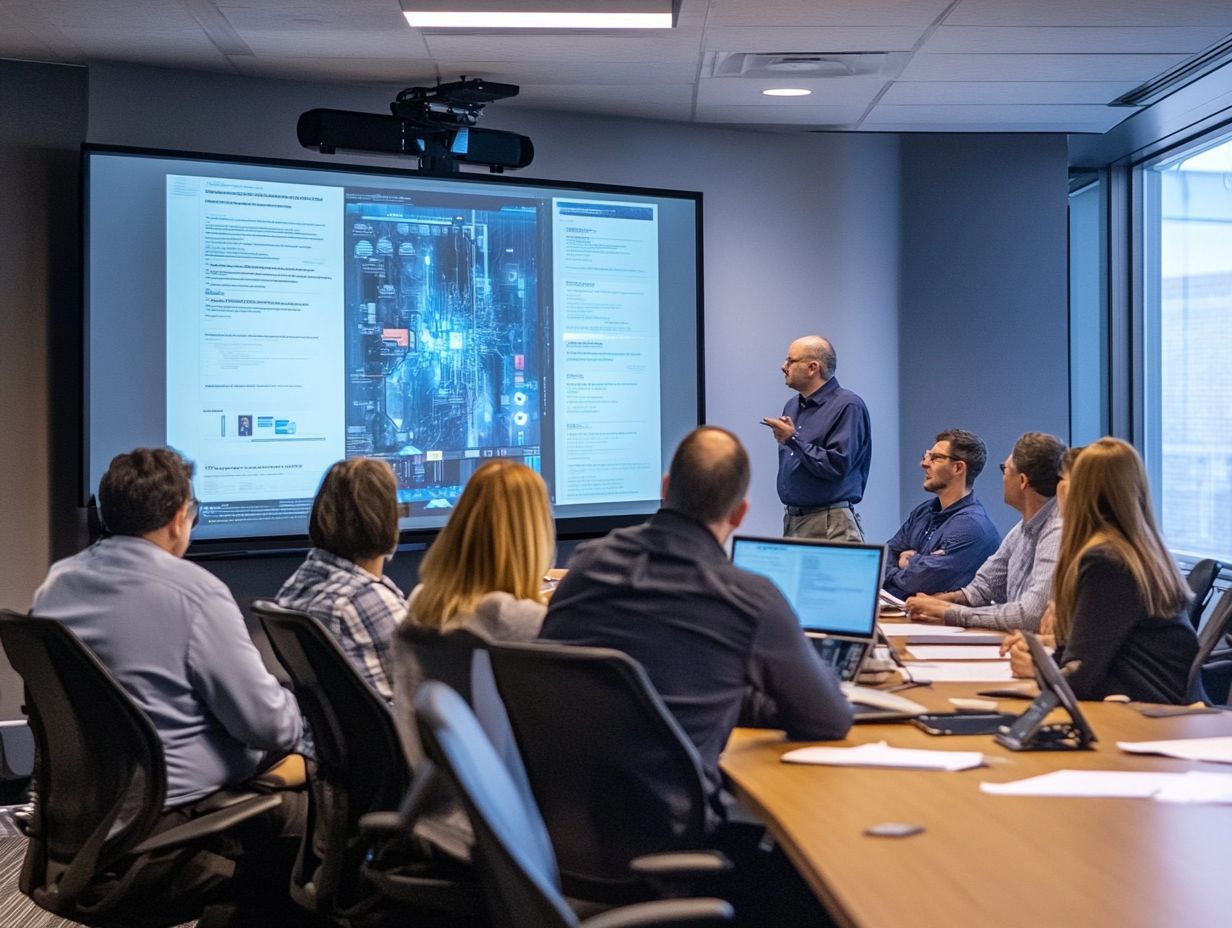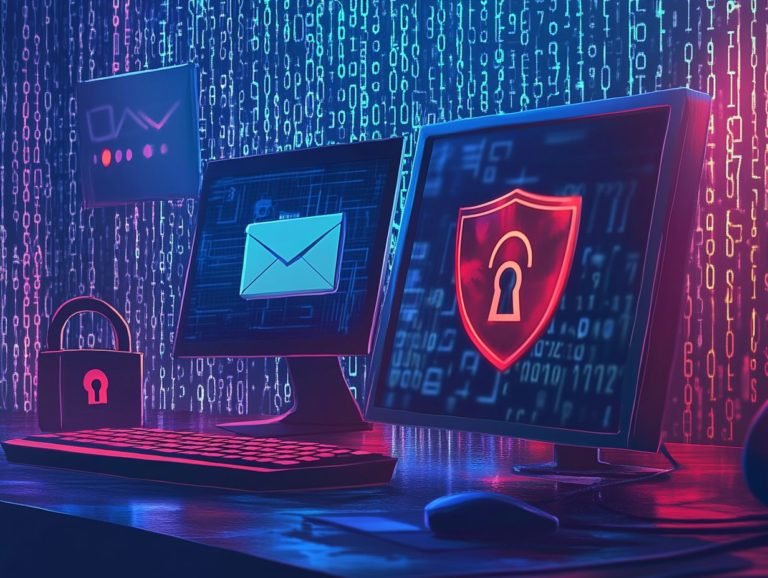how can i build a cybersecurity culture at work?
In today s digital landscape, building a strong cybersecurity culture is vital for businesses, regardless of their size.
As cyber threats continue to escalate, grasping the risks and their potential repercussions on organizations and employees is imperative.
Let s dive into the essential components of developing an effective cybersecurity culture. It emphasizes the importance of a top-down approach, robust policies, and ongoing training and vigilance.
Discover how to foster an environment where cybersecurity evolves into a shared responsibility, becoming a fundamental pillar of your organization s success.
Contents
- Key Takeaways:
- The Importance of a Cybersecurity Culture
- Creating a Cybersecurity Culture
- Implementing Cybersecurity Policies
- Enforcing and Updating Policies
- Maintaining a Cybersecurity Culture
- Frequently Asked Questions
- How can I build a cybersecurity culture at work?
- Why is it important to build a cybersecurity culture at work?
- What are some ways to promote a cybersecurity culture at work?
- How do I convince management to support cybersecurity initiatives?
- How can I encourage employees to take responsibility for cybersecurity?
- What should I do if an employee makes a cybersecurity mistake?
Key Takeaways:
- Build a cybersecurity culture to safeguard your business and employees.
- A top-down approach and employee training are essential for a strong cybersecurity culture.
- Regular assessments, updating policies, and rewarding good practices are key to maintaining a strong cybersecurity culture at work.

The Importance of a Cybersecurity Culture
Establishing a strong cybersecurity culture is essential for organizations intent on keeping data safe in today s intricate digital landscape, rife with cyber threats.
This culture promotes a shared sense of responsibility among every level of the organization from employees to management and IT teams cultivating a proactive approach to risk management and data protection.
By making cybersecurity a fundamental part of your organizational ethos, you not only protect sensitive information but also empower your workforce.
Through comprehensive employee training and security policies that emphasize accountability and best practices, you create an environment where everyone is invested in maintaining security.
Understanding the Risks
It s crucial to understand cybersecurity risks to mitigate potential cyber threats and protect your digital assets from malicious activities like phishing attacks. Phishing attacks are attempts to trick people into giving away sensitive information.
In today s digital landscape, organizations face various cyber risks that can present significant challenges, often arising from human error, system vulnerabilities, and outdated protocols.
For instance, a recent study revealed that an astonishing 95% of cybersecurity breaches can be traced back to human mistakes. This highlights the vital importance of employee training in fostering a security-first culture.
Consider organizations like Target, which have suffered severe consequences due to lapses in cybersecurity measures costing them millions and tarnishing their reputation. This serves as a powerful reminder of how important it is to promote awareness and proactive behaviors among employees, which are essential for anticipating and effectively managing diverse cyber threats.
Impact on Business and Employees
The impact of building a strong cybersecurity culture within your organization is profound. It enhances operational efficiency, ensures compliance with regulatory requirements, and fosters a sense of security and trust among employees.
This culture encourages team members to be proactive, making them more vigilant and mindful of potential threats. When staff understand the importance of cybersecurity protocols, they re more likely to adhere to established policies, which directly contributes to fewer breach incidents.
Implementing comprehensive training programs and clear security guidelines is essential for instilling this mindset, equipping individuals with the knowledge they need to recognize and respond to risks effectively.
Ultimately, by embedding cybersecurity into your corporate ethos, you enable your employees to take ownership of their roles in safeguarding sensitive information, thereby boosting overall productivity and maintaining a secure environment.
Creating a Cybersecurity Culture
Establishing a strong cybersecurity culture within your organization demands a strategic, top-down approach. It’s essential to secure unwavering commitment from management and to highlight the significance of how to foster a security-conscious workforce among every employee.
This ensures that cybersecurity transcends mere policy and becomes an integral aspect of your organizational ethos.
Top-down Approach

A top-down approach to establishing a cybersecurity culture is essential to safeguard your organization’s future. It ensures that management actively participates in and supports necessary security measures while holding every employee accountable for their actions. Additionally, understanding the role of feedback in cybersecurity culture can further strengthen this initiative.
When leaders model best practices and show genuine commitment to securing sensitive information, they significantly influence the overall organizational culture. This involvement boosts the effectiveness of security policies and encourages team members to adopt similar behaviors.
To accurately gauge the current security situation, conducting a culture assessment is essential. This assessment should include surveys, interviews, and focus groups to gather insights into employee attitudes and awareness regarding cybersecurity protocols.
Integrating feedback from these assessments allows you to tailor training programs and policies to better align with the actual cultural dynamics and operational needs of the organization.
Employee Training and Education
Employee training and education form the bedrock of a robust cybersecurity culture. They equip employees with the knowledge and skills necessary to recognize and address potential threats while cultivating a commitment to cybersecurity best practices.
Organizations can deploy a range of training programs, from fundamental awareness courses to advanced technical exercises tailored specifically to various roles. These programs convey essential security concepts and simulate real-life scenarios, allowing employees to practice their responses to incidents.
The significance of such training is profound, fostering a culture of security awareness that becomes second nature in the workplace. Championing continuous learning ensures that employees remain agile and well-informed, adeptly navigating the ever-changing landscape of cybersecurity threats.
This proactive strategy not only safeguards organizational assets but also enhances confidence, cultivating a culture of shared responsibility toward security.
Implementing Cybersecurity Policies
Implementing effective cybersecurity policies is crucial for protecting your organization s digital assets. It establishes compliance requirements and creates a structured framework for addressing potential cyber incidents and threats.
Prioritizing these measures enhances security and cultivates a resilient environment that can adeptly navigate the complexities of the digital landscape.
Key Policies to Establish
- Data Protection Strategies: Develop comprehensive data protection strategies to ensure information is encrypted, access is meticulously controlled, and regular audits strengthen your overall security posture.
- Incident Response Plan: Create a solid incident response plan that outlines actionable steps to address and recover from cybersecurity breaches quickly, minimizing the impact on critical assets.
- Risk Management Protocols: Implement risk management protocols to identify vulnerabilities and assess threats, allowing for efficient resource allocation.
- Compliance Alignment: Align these strategies with compliance requirements to avoid penalties and cultivate trust with clients and stakeholders by demonstrating a proactive commitment to protecting organizational assets.
Enforcing and Updating Policies
Enforcing and updating cybersecurity policies is essential for navigating the ever-evolving landscape of cyber threats. This process ensures accountability within your organization and compliance with regulations.
This systematic review requires your teams to assess existing policies for relevance and effectiveness in light of new risks. By conducting regular audits and actively seeking feedback from employees, you can identify gaps and reinforce your defenses.
Integrating modern security measures, such as tools that help spot unauthorized access to your network, is crucial in strengthening these policies. It’s important for you and your stakeholders to stay informed about emerging cyber threats. Your policies should not only serve as a clear framework for response but also foster a culture of security mindfulness among your staff.
Maintaining a Cybersecurity Culture

To cultivate a robust cybersecurity culture, you must engage continuously. Conduct regular assessments and implement proactive updates to tackle emerging challenges.
This approach ensures that security consistently remains a top priority within your organization.
Regular Assessments and Updates
Conducting regular assessments and updates is crucial for evaluating the effectiveness of your cybersecurity culture. Make necessary adjustments to your risk management strategies.
Employing various methods like surveys, interviews, and workshops allows you to gather valuable feedback from employees about their understanding and practices concerning cybersecurity. These feedback loops are essential for pinpointing knowledge gaps and encouraging a proactive approach to security.
As the threat landscape evolves, staying agile is vital. Adapt your training and policies to address emerging vulnerabilities. This proactive stance not only bolsters your organization’s resilience but also enables your employees to take an active role in protecting sensitive information.
Rewarding and Recognizing Good Practices
Recognizing good practices within a cybersecurity culture is essential for getting employees involved and responsible. It encourages proactive measures in safeguarding your organization’s assets.
You can recognize good practices in many ways, such as spot bonuses, public acknowledgments during team meetings, or dedicated programs that highlight exemplary behavior. By implementing these incentives, your organization not only motivates you and your colleagues but also helps cultivate an environment where cybersecurity takes center stage.
When standout actions are showcased, you and your peers are more likely to emulate these positive behaviors. This creates a ripple effect that strengthens the overall security posture.
Ultimately, these initiatives play a crucial role in developing a culture of security, where every individual feels valued and responsible for maintaining the integrity of digital assets.
Start your journey toward a robust cybersecurity culture today!
Frequently Asked Questions
How can I build a cybersecurity culture at work?
Building a cybersecurity culture at work starts with educating employees on the importance of cybersecurity and the potential risks. A great resource for this is understanding how to educate my team about cybersecurity. This can include regular trainings, workshops, and reminders about best practices.
Why is it important to build a cybersecurity culture at work?

A strong cybersecurity culture at work can help prevent cyber attacks and data breaches, protecting sensitive company and customer information. To enhance this culture, it’s important to consider how to implement a cyber awareness program that fosters a sense of responsibility among employees to keep the company safe.
What are some ways to promote a cybersecurity culture at work?
Aside from regular trainings, implement policies and procedures that prioritize cybersecurity. This includes using strong passwords, regularly updating software, and limiting access to sensitive information.
How do I convince management to support cybersecurity initiatives?
To get buy-in from upper management, demonstrate the potential risks and costs of a cyber attack. Highlight the benefits of implementing a strong cybersecurity culture by sharing industry statistics and success stories from other companies.
How can I encourage employees to take responsibility for cybersecurity?
Encourage employees to take charge of cybersecurity by making it part of their job roles.
Include it in performance reviews to create a sense of accountability.
What should I do if an employee makes a cybersecurity mistake?
If an employee makes a cybersecurity mistake, have a clear plan ready for handling it.
This plan should outline steps for fixing the issue and preventing it from happening again.






